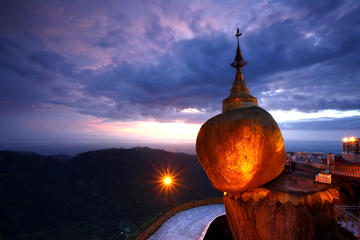Kyaiktiyo Pagoda (Golden Rock)
TIME : 2016/2/22 12:06:07

Kyaiktiyo Pagoda (Golden Rock)
The Golden Rock, also known as the Kyaiktiyo Pagoda because of the Stupa on top of it, is just what it sounds like: a somewhat surreal looking, gold shimmering boulder that seems to completely defy gravity, threatening to drop into the adjoining 1,100-meter deep abyss at any moment. The legend says that for over a thousand years, a single hair of Buddha has been holding the roughly head shaped piece of granite in equilibrium. While the legend stands in contrast to the geological explanation, the reason why the rock seems to be made of solid gold is noticeable immediately. Women aren’t allowed to touch the big nugget, but men crowd around the bottom, sticking golden flakes on the stone, kneeling in prayer and wrapped in the smoke of incense.
Buddhism is omnipresent in Myanmar and accordingly the Kyaiktiyo Pagoda is one of the most important pilgrimage sites in the country. Up to 50,000 people visit on important days to see the rock that has survived centuries of weathering, earthquakes and erosion, while an average day usually attracts around 15,000 pilgrims. Although there is an air of devotion surrounding the site, the area has also been developed into a true tourist site providing everything you might need on the mountain, from accommodation, platforms, various buildings to food stalls selling delicious pancakes, skewers, fried fish and rice noodles.
Practical Info
If you are setting out to see the Kyaiktiyo Pagoda from the capital Yangon, the four-hour drive to the basecamp in Kinpun is best made by taxi or by bus from the Aung Mindalar Bus Station. From this town at the foot of the Kyaikhtiyo Mountain, further progress is only possible by pickup truck. Another 45 bumpy minutes later, all motorized transport ceases at the second basecamp and the last leg of the journey has to be completed via a steep four-kilometer hike up the mountain. People who aren’t in great shape can also hire a bamboo litter to carry them the rest of the way. The sacred site can be visited at all times of day, but sunrise and sunset is said to be especially magical.
